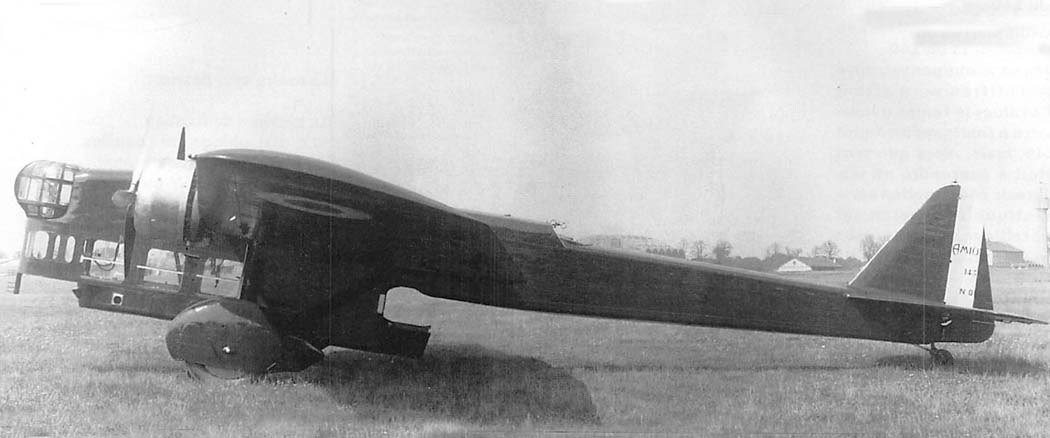Well Zack,
Thanks for the Amiot 143 - it was a tough choice for me between that slabsided crate and the Wellesley.
The Amiot flew some missions too!

from wiki :
The Amiot 143M was a late 1930s French medium bomber designed to meet 1928 specifications for a bomber capable of day/night bombing, long-range reconnaissance and bomber escort.
The Amiot 140 was a high-winged cantilever monoplane of all-metal construction, with corrugated wing skinning and a fixed tail wheel undercarriage. The pilot sat in an open cockpit, with separate cockpits for gunners in the nose and dorsal positions. A glazed gondola under the forward fuselage carried a bombardier/gunner, ensuring that the gunners had a clear field of fire all around the aircraft.
The French Air Ministry had meanwhile revised its requirements, requiring better performance and better bombing capability, and Amiot redesigned the aircraft to meet these requirements and incorporate lessons learned during testing of the Amiot 140. The gondola under the fuselage was enlarged, allowing easier operation of the aircraft's guns, and allowing a fifth crew member (a radio-operator) to be carried. Manually operated gun turrets were provided in the nose and dorsal positions. Orders were placed for two prototypes, differing only in the engines fitted, with the Amiot 142 having Hispano-Suiza 12Y engines and the Amiot 143 having Gnome-Rhone 14K radial engines. The 143 flew first, on 1 August 1934, with the 142 not flying until January 1935. As it was decided to allocate the Hispano-Suiza engines to fighters, the Amiot 143 was selected, the existing order for 40 Amiot 140s being converted to 143s.
Clandestine photo of Ranwers showing plans for his next project and being swarmed by SAS hopefuls!!


After 40 aircraft had been completed, the design was revised, with the aircraft being fitted with a longer nose (increasing overall length from 17.94 m (58 ft 10 in) to 18.24 m (59 ft 10 in), a revised fuel system, and with the Lewis guns in the nose and dorsal turrets and the ventral position replaced by single 7.5 mm (.295 in) MAC 1934 machine guns, with a fourth gun used by the navigator/bombadier firing through a hatch in the floor.
Deliveries of the aging design eventually began in April 1935, continuing until March 1937, with a total of 138 being built.
Despite being of an ungainly two-tiered structure, slow and lacking maneuverability, and of obsolescent architecture, the Amiot 143M was a sturdy plane which was popular with its pilots.
At the outbreak of the Second World War, Amiot 143s equipped 5 metropolitan groupes together with a single African based groupe.
During the Phoney War, Amiot 143M groupes carried out reconnaissance and leaflet raids over Germany. 87 Amiot 143M remained in front line service on 10 May 1940, 50 equipping four metropolitan groupes: GBs I/34 and II/34 in the north, GBs I/38 and II/38 in the East, and 17 equipping one African groupe, GB II/63, which was in the process of re-equipping with Martin 167Fs. Following the start of the Battle of France, the Amiot 143M was mainly used in night attacks against German airfields and lines of communications, with losses relatively low.One notable exception was a daylight raid by 10 Amiots from GBs I/34, II/34, and II/38 led by Commandant de Laubier against German bridgeheads near Sedan on 14 May 1940. Despite fighter escort, two Amiots were shot down while a third force-landed before reaching its base.
By the time of the Armistice, the Amiot 143M had dropped a total of 474 tonnes (523 tons) of bombs.52 Amiot 143Ms were in the Unoccupied Zone and 25 were in French North Africa.[18] They were reorganized into GBs I/38 and II/38 and were used until July 1941 when they were replaced by LeO 451 bombers.
All dolled up for the ball.

Some planes of the II/38 served as a transports for the French in Syria. This groupe later went over to the Allied side after their landings in Africa. The last Amiot 143M was retired from service in February 1944.
General characteristics
Crew: Five (pilot, navigator/bombardier, radio operator, nose and dorsal gunners)
Length: 18.24 m (59 ft 10 in)
Wingspan: 24.53 m (80 ft 5¾ in)
Height: 5.68 m (18 ft 7¾ in)
Wing area: 100 m² (1,076 ft²)
Empty weight: 5,455 kg (12,026 lb)
Loaded weight: 8,611 kg (18,983 lb)
Max. takeoff weight: 10,360 kg (22,839 lb)
Powerplant: 2 × Gnome et Rhône 14Kirs / Gnome et Rhône 14Kjrs 14-cylinder air-cooled radial engine, 640 kW (858 hp)870 cv each
Performance
Maximum speed: 295 km/h (159 knots, 183 mph) at 3,400 m (11,160 ft)
Range: 1,300 km (703 nmi, 808 mi) (max bomb load)
Ferry range: 1,995 km (1,078 nmi, 1,240 mi)
Service ceiling: 7,500 m (24,605 ft)
Climb to 2,000 m (6,560 ft): 6.8 min
Armament
Guns: 4× 7.5 mm (.295 in) MAC 1934 machine guns (one each in nose and dorsal turrets, forward gondola and rear gondola)
Bombs: 800 kg (1,760 lb) internally, 800 kg (1,760 lb) externally
Cheers
Kopfdorfer
 Author
Topic: Ugliest Bomber? Nominate your favourite! (Read 53075 times)
Author
Topic: Ugliest Bomber? Nominate your favourite! (Read 53075 times)


